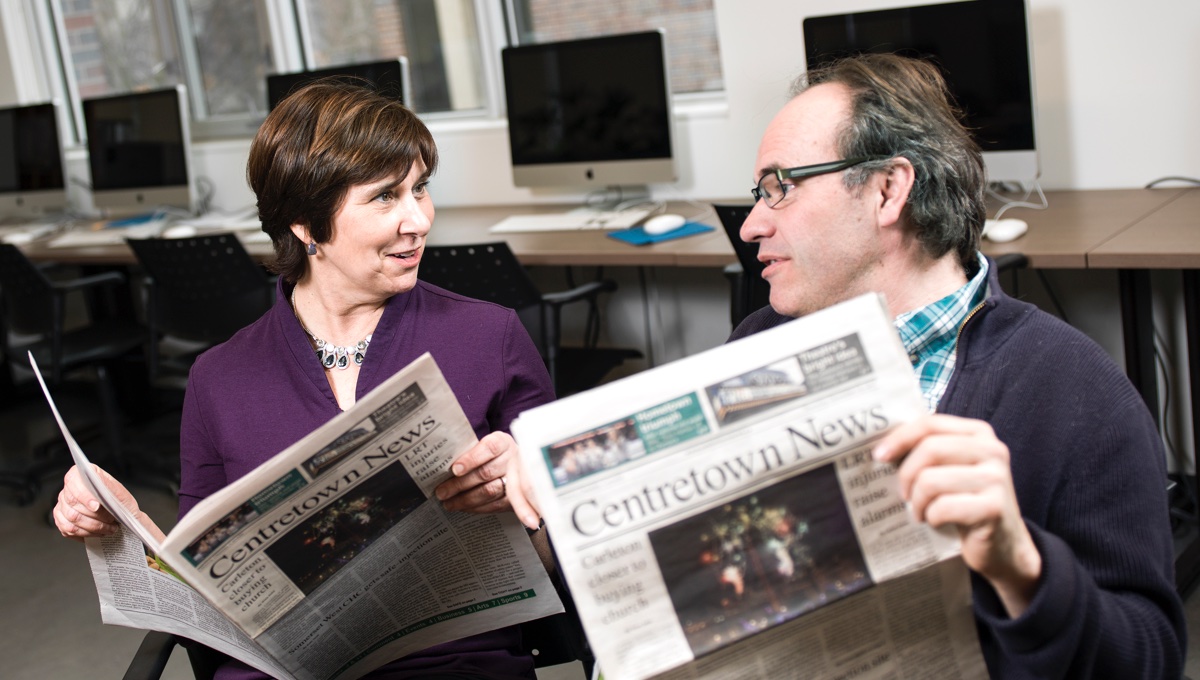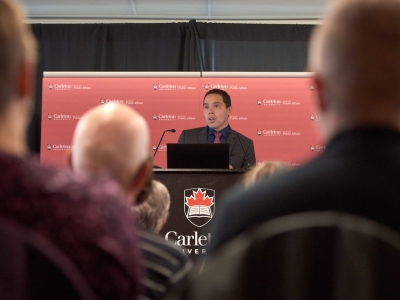By Dan Rubinstein
Photos by Josh Hotz and Chris Roussakis
In September, when Carleton journalism students return to campus, they’ll continue reporting and publishing stories that matter to Ottawa residents, from breaking news and in-depth coverage of important issues to offbeat features and profiles of local personalities. But the outlet for these stories is evolving with the times.
The new digital-only Capital Current will merge the journalism program’s biweekly Centretown News print newspaper — the last edition will hit the streets in mid-April — and the multimedia student publication Capital News Online.
Capital Current (tagline: “Covering Ottawa Communities”) is part of a longstanding tradition of local outreach for both the university and Carleton’s School of Journalism and Communication. And next fall, with roughly 100 third- and fourth-year students working on the publication at any given time, plus additional content gleaned from the best classroom assignments produced by their peers, journalists-in-training will be able to polish the digital storytelling skills they’ll need to work in the industry. At the same time, they will give people in Centretown and other Ottawa neighbourhoods the stories and information they may be missing as media companies pull out of the local market.
“This is an evolution in several different ways,” says Journalism Prof. Randy Boswell, the publisher of Centretown News and instructor of third-year, fourth-year and master’s students who will contribute to Capital Current. “It’s an evolution of the way we teach journalism, an evolution of the university’s relationship with the city’s communities, and it’s an evolution of journalism itself, which is very much a changing game.
“Digital tools and social media have enabled a richer and much more fluid conversation back and forth between the public and traditional gatekeepers of news. It’s an interesting moment that we can move forward into.”

Dynamic and interactive online publication
Rather than spend time and energy producing a newspaper, which costs the school about $40,000 a year for printing and distribution, the focus will now be fully on creating a dynamic interactive online publication.
As a neighbourhood, Centretown will remain a priority: it’s downtown and that’s where a lot of news happens. But Capital Current will broaden its range, telling stories across Ottawa’s geographic communities, as well as its demographic communities, such as Indigenous, immigrant and LGBTTQ+ groups.
With guidance from faculty who are seasoned professional journalists as well as teachers, students working individually and in teams will come up with story ideas and then do research and reporting, leading to a range of different types of content, from traditional words-and-pictures articles to photo slideshows, videos, podcasts, map-based narratives, data-driven infographics and more. Some of these stories may emerge from feedback shared by Ottawa residents who ask for coverage exploring specific issues in their communities.
“We value the core skills of writing, reporting and research, but today’s journalist has to be really adept at digital skills as well,” says instructor Janice Tibbetts, who teaches a third-year multimedia journalism class with 50 or so students who will be major contributors to the new publication.
“We teach students digital tools and multimedia tools in second year, so by the time they get to third and fourth year, they will have mastered the skills that they’ll be able to use and showcase on Capital Current— and they’ll be able to use those skills in creative ways that they come up with themselves. At the end of the day, it’s just a different way of telling stories, and we emphasize the importance of solid journalism throughout every step.”
“There’s a big difference between an assignment that’s handed in to the teacher and one that’s going to be published in the public realm,” adds Boswell. “The sources you’ve spoken to are going to see what you’ve produced, and if you haven’t faithfully recorded their views, you’re going to hear about it. In this laboratory setting, students have the opportunity to interact with people in the community who are wrestling with difficult issues, and great people who’ve done neat things whose stories we want to tell. This is a nice intersection of a teaching enterprise with a real-world journalistic enterprise.”
“We’ve been doing experiential learning in journalism for a long time — and this is a very powerful type of experiential learning,” says Tibbetts. “It involves a lot of people doing every day for a long time something they’ll be doing in the real world.
“It’s exciting. I like building things. I like being in on the ground floor.”
Learning through local coverage
There’s tremendous value in learning how to be a journalist by covering your local community, which is how many reporters begin their careers, even if their dream jobs involve overseas travel.

Three years ago, when Associated Press’s Canadian-born Islamabad Bureau Chief Kathy Gannon spoke at Carleton about her work covering conflict in the Middle East, she stressed the foundational importance of community reporting.
“This incredibly accomplished international journalist,” Boswell recalls, “told our students that to hone the skills you need to be a good foreign correspondent, you first have to do things that often seem very mundane, like covering city council or board of education stories. You need to understand a familiar local environment first, so you can begin to understand how society works, how decisions are made, how special interests compete and/or co-operate to make a community better.”
“If you can do the little things right, then you’re ready for the big stories when they come along,” says Tibbetts, a longtime justice reporter for Postmedia News who began her newspaper career at the Halifax Daily News, an urban tabloid that ceased publishing in 2008 and had grown out of a community paper called the Bedford-Sackville News. “And you’re directly accountable to the subjects of your stories, because they’re right there.”
Boswell, a former city hall reporter and city editor at the Ottawa Citizen, also has community-paper roots. As a teenager, he wrote for his hometown Grand Valley Star & Vidette northwest of Toronto, and he was a reporter, photographer and editor for Centretown News while studying at Carleton in the late 1980s.
Centretown News was established as a neighbourhood newsletter around 1970 by the Centretown Citizens Community Association (CCCA). It’s still a leading voice in Centretown (Somerset ward in municipal parlance), which is home to about 40,000 people who live in the area bounded by the O-Train line on the west, the Rideau Canal on the east, the Queensway and Carling Avenue on the south and the Ottawa River on the north.
Carleton’s journalism program teamed up with the CCCA in the early 1970s to transform the association’s publication into a more robust newspaper, which has been published independently by the university for the last four decades, with a shift toward more online content at centretownnews.ca in recent years reflecting the changing media landscape and the way audiences consume news these days.
“We already have a pretty dynamic web presence,” says Boswell, “but when we have our full focus on the digital channels that Capital Current represents, it’s going to be a really great opportunity for experimentation and for creative development.”
Students cover breaking news
Over the years, Carleton students working on Centretown News have broken stories that were picked up by mainstream media such as the Ottawa Citizen and CBC — including the city’s plan to allow camping in local parks during last summer’s Canada 150 celebrations — and leapt into action to cover breaking news, such as the Parliament Hill shootings in October 2014.

“That was a very memorable moment,” says Boswell, recalling how the paper was a couple hours away from being printed when the shootings occurred. Students responded in real time, providing frequent news updates on the Centretown News website and via social media channels such as Twitter.
This type of responsiveness will be one of the hallmarks of Capital Current, with students no longer tasked with shaping stories that have a two-week print shelf life. The plan to listen to what community members want to see in the publication should also lead to greater relevance.
“Students will be more exposed to daily journalism,” says Tibbetts, “but they’ll also be writing long-form features and analyzing issues, which people both like to write and like to read about, so they know what’s happening, not just what happened.”
“This kind of publication can be very flexible and help define communities in different ways,” adds Boswell. “It’s an example of how we can reach out into these communities and help ourselves understand the place we live in. We can move much more swiftly, and bring a greater diversity of skills and tools and platforms to the whole experience of covering a community without the labour-intensive ‘distraction’ of a print edition to produce every two weeks.
“Integration with the local community is a broad ethic that Carleton values,” he continues. “It has always been part of what Carleton is. I would say that Capital Current is not only building on that tradition, but actually taking it in an interesting new direction, because we’ll be immersed much more fully in what’s happening in local communities — plural — around the city, and helping to identify those communities in some ways that don’t necessarily have manifestations in the media.
“There will be an ongoing interest in and demand for print publications in the foreseeable future, and there will be news organizations that continue to fill that need,” he adds. “But it’s not an ideal model for what we’re doing at the School of Journalism and Communication. We have to prepare students for a world that’s changing very dramatically and has already shifted decisively to a digital-first model for news. So, it would be problematic to continue producing a print publication that takes too much time, energy and effort away from the digital channels that we need to be commanding. Students need to have as much experience and immersion as possible in all those ways of telling stories.”
Thursday, March 29, 2018 in Journalism and Communication
Share: Twitter, Facebook



